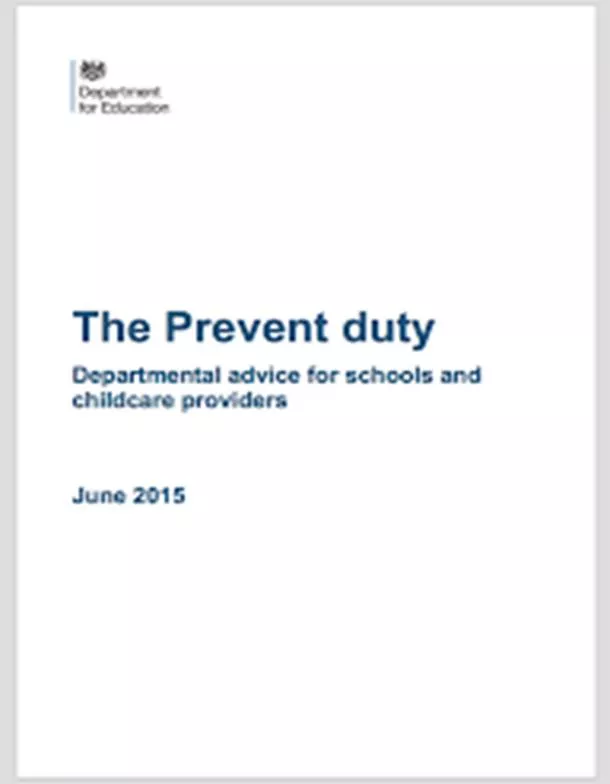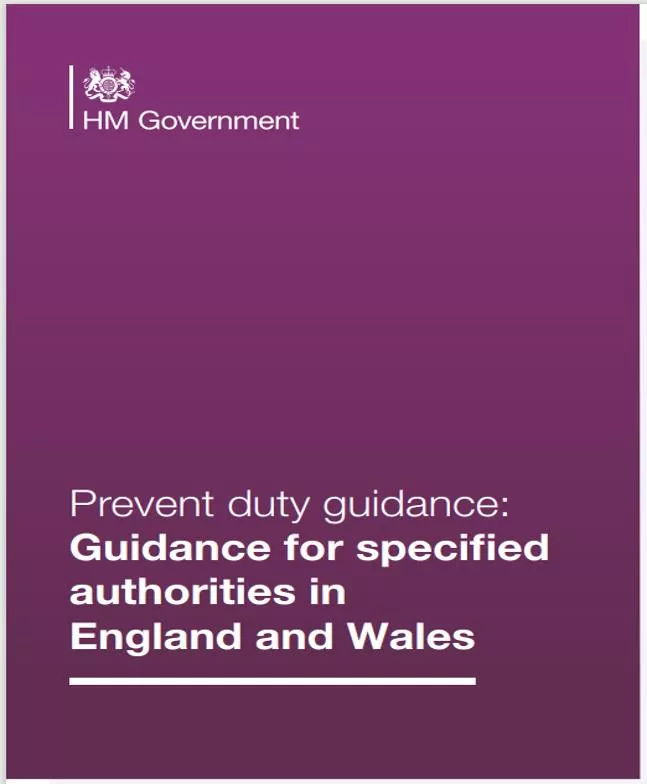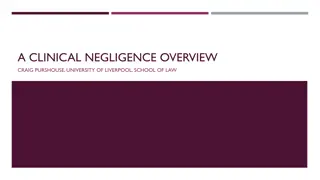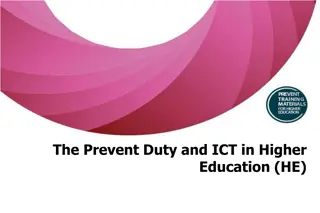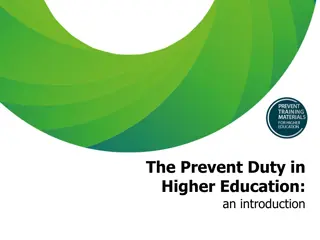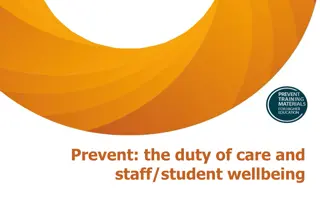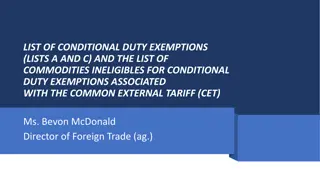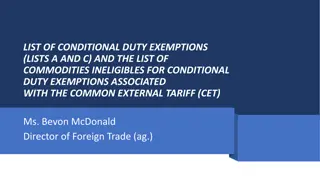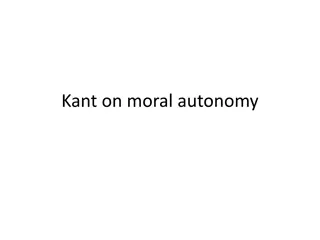Prevent Duty Guidance in the UK Education Sector
Statutory guidance under the Counter Terrorism and Security Act 2015 outlines the Prevent Duty, requiring authorities to prevent individuals from being drawn into terrorism. The guidance specifies responsibilities for various sectors, including local authorities, police, education, health, and criminal justice agencies. It emphasizes the importance of due regard and the need to prevent radicalization. The guidance targets senior leadership, individuals with Prevent and/or safeguarding roles, and those in frontline positions likely to engage with vulnerable individuals.
Download Presentation

Please find below an Image/Link to download the presentation.
The content on the website is provided AS IS for your information and personal use only. It may not be sold, licensed, or shared on other websites without obtaining consent from the author.If you encounter any issues during the download, it is possible that the publisher has removed the file from their server.
You are allowed to download the files provided on this website for personal or commercial use, subject to the condition that they are used lawfully. All files are the property of their respective owners.
The content on the website is provided AS IS for your information and personal use only. It may not be sold, licensed, or shared on other websites without obtaining consent from the author.
E N D
Presentation Transcript
The New Prevent Guidance Hayley Cameron Education Safeguarding Manager Steve Welding Education E Safety Advisor www.cognus.org.uk
Independent Review of Prevent Local Authority Police Education Health Criminal Justice Agencies (Prison & Probation) l Comes into effect on 31st December 2023
Counter Terrorism and Security Act 2015. As of the 1st July 2015 Creates a new duty on certain bodies to have DUE REGARD TO THE NEED TO PREVENT PEOPLE FROM BEING DRAWN INTO TERRORISM . The duty will apply to bodies including local authorities, the police, prisons, probation, schools, colleges and universities. There are no new legal requirements placed on Educational settings.
Prevent duty guidance The Prevent duty does not confer new functions on any specified authority. The term due regard as used in the CTSA 2015 means that the authorities should place an appropriate amount of weight on the need to prevent people from becoming terrorists or supporting terrorism when they consider all the other factors relevant to how they carry out their usual functions. The purpose of this guidance is to set out the expectations for each of the main statutory sectors and describe the ways in which they should comply with the Prevent duty.
Specified Authorities Local Authority Police Education Health Criminal Justice Agencies (Prison & Probation)
Who is this guidance for? This statutory guidance is intended for use by: senior leadership teams in any of the specified authorities listed in Part 1 of Schedule 6 of the CTSA 2015 those with dedicated Prevent and/or safeguarding responsibilities people in specified authorities with responsibility for how resources and funding are used, and for external partnerships those in a frontline role and likely to engage with people who may be susceptible to radicalisation
What is the status of this guidance? This is statutory guidance from the Home Office, issued under Section 29 of the CTSA 2015. It comes into force on 31st December 2023.
CONTEST (Counter Terrorist Strategy) Prevent: to stop people becoming terrorists or supporting terrorism. Pursue: to stop terrorist attacks. Protect: to strengthen our protection against a terrorist attack. Prepare: to mitigate the impact of a terrorist attack. CONTEST: The United Kingdom s Strategy for Countering Terrorism 2018
The Prevent duty The aim of Prevent is to stop people from becoming terrorists or supporting terrorism. Prevent also extends to supporting the rehabilitation and disengagement of those already involved in terrorism. The Prevent duty requires specified authorities such as education, health, local authorities, police and criminal justice agencies (prisons and probation) to help prevent the risk of people becoming terrorists or supporting terrorism. The duty helps to ensure that people who are susceptible to radicalisation are supported as they would be under safeguarding processes.
Government Prevent Objectives The objectives of Prevent are to: tackle the ideological causes of terrorism intervene early to support people susceptible to radicalisation enable people who have already engaged in terrorism to disengage and rehabilitate
Prevent delivery model The Prevent delivery model sets out how we tackle the ideological causes that lead to radicalisation, intervene early to support those who are susceptible to radicalisation, and rehabilitate those who have already engaged with terrorism. To tackle the ideological causes of terrorism, Prevent focuses on reducing the influence of radicalisers on susceptible audiences, as well as reducing the availability of, and access to, terrorist content. Our work to counter radicalisation and reduce permissive environments extends across academia, civil society, communities, government and industry.
Interventions Prevent intervenes early by identifying people who are susceptible to radicalisation and providing support to those suitable for intervention. Where the police assess a radicalisation risk following a Prevent referral, a Channel panel will meet to discuss the referral, assess the risk and decide whether the person should be accepted into Channel. Once accepted, the panel agree a tailored package of support to be offered to the person. The panel is chaired by the local authority and attended by multi-agency partners such as police, education professionals, health services, housing and social services. Channel is a voluntary process, and people must give their consent before they receive support. In cases where the person is under 18 years of age, consent is provided by a parent, guardian or the agency that has responsibility for their care. Where risks cannot be managed in Channel, they will be kept under review by the police.
Rehabilitation Rehabilitation seeks to reduce the risk of people who have been involved in terrorist-related activity, including those who have been convicted of offences. The Desistance and Disengagement Programme provides specialist Home Office- approved intervention providers to give support in the form of theological, ideological and practical mentoring to reduce the offending risk.
Threat and risk Prevent deals with all kinds of terrorist threats to the UK. Prevent s first objective is to tackle the ideological causes of terrorism. The ideological component of terrorism is what sets it apart from other acts of serious violence. Islamist ideology is resilient and enduring. Extreme Right-Wing ideology is resurgent. Other ideologies are less present, but still have the potential to motivate, inspire and be used to justify terrorism.
Ideology A terrorist ideology is a set of beliefs, principles, and objectives to which an individual or group purports to adhere and attempts to instil in others to radicalise them towards becoming terrorists or supporting terrorism. There are several concepts or tools that often feature in terrorist and extremist ideologies, including: narrative, propaganda, grievances, and conspiracy theory
Extreme Right-Wing Terrorism (ERWT) Describes those involved in Extreme Right-Wing activity who use violence in furtherance of their ideology. These ideologies can be broadly characterised as Cultural Nationalism, White Nationalism and White Supremacism. Individuals and groups may subscribe to ideological tenets and ideas from more than one category
Islamist terrorism Is the threat or use of violence as a means to establish a strict interpretation of an Islamic society. For some this is a political ideology which envisions, for example, the creation of a global Islamic caliphate based on strict implementation of shari ah law. Many adherents believe that violence (or jihad as they conceive it) is not only a necessary strategic tool to achieve their aims, but an individual s religious duty. In the UK the Islamist terrorist threat comes overwhelmingly from those inspired by, but not necessarily affiliated with, Daesh and/or al-Qa ida, but they operate within a wider landscape of radicalising influences as set out in the government s response to the Independent Review of Prevent. Islamist should not be interpreted as a reference to individuals who follow the religion of Islam.
Left Wing, Anarchist and Single-Issue Terrorism (LASIT) Encompasses a wide range of ideologies. It includes those from the extreme political left-wing as well as anarchists who seek to use violence to advance their cause in seeking to overthrow the State in all its forms
Online radicalisation Describes situations where the internet is believed to have played a role in a person s radicalisation pathway. The internet can play two broad roles in radicalisation (offering mechanisms often unavailable to people offline). These are: exposure to extremist and terrorist content and socialisation within likeminded networks. Often this is facilitated by highly permissive environments online.
Permissive environment A permissive environment may be characterised as being tolerant of behaviour or practices strongly disapproved of by others, such as an environment where radicalising ideologies are permitted to flourish. Radicalisers create and take advantage of permissive environments to promote or condone violence and to spread harmful ideologies that undermine our values and society. Permissive environments can exist both online and offline. Permissive online environments can contribute to online radicalisation.
Susceptibility Is complex and unique to a person s circumstances. Within Prevent, susceptibility refers to the fact that a person may be likely or liable to be influenced or harmed by terrorist and extremist ideologies that support or radicalise people into terrorism. Please see the susceptibility to radicalisation section of the Prevent duty guidance 2023. As set out in the Prevent duty guidance, a person s susceptibility may be linked to their vulnerability (see vulnerability below), but not all people susceptible to radicalisation will be vulnerable. There may be other circumstances, needs or other underlying factors that may make a person susceptible to radicalisation but do not constitute a vulnerability. Vulnerability Describes the condition of being in need of special care, support, or protection because of age, disability, risk of abuse or neglect.
Terrorism The current UK definition is set out in the Terrorism Act 2000 (TACT 2000). In summary this defines terrorism as The use or threat of serious violence against a person or serious damage to property where that action is: designed to influence the government or an international governmental organisation or to intimidate the public or a section of the public; and for the purpose of advancing a political, religious, racial or ideological cause. Radicalisation Is the process of a person legitimising support for, or use of, terrorist violence.
Educational Settings Children and young people continue to make up a significant proportion of Channel cases, and in recent years there have been concerns regarding increased numbers of learners being arrested for terrorism-related offences. Educators are often in a unique position, through interacting with learners on a regular basis, to be able to identify concerning behaviour changes that may indicate they are susceptible to radicalisation. Settings should not only be alert to violent extremism but also non-violent extremism, including certain divisive or intolerant narratives which can reasonably be linked to terrorism. Educate Against Hate and GOV.UK Prevent duty training provide further information on extremist narratives
Educational Settings Compliance with the Prevent duty will reflect existing good practice on safeguarding. For example, it will ensure susceptibility to radicalisation is incorporated into safeguarding training, policies and risk assessments. It is not anticipated that compliance will result in additional burdens on settings. The guidance uses the term setting to refer to all education providers who are specified authorities subject to the Prevent duty, and the term learner to refer to pupils and students across all phases of education provision.
Educational Settings All education providers should have a designated lead in a senior management role who is responsible for the delivery of Prevent. They should ensure that there are appropriate capabilities (to understand and manage risk) and that the role and importance of Prevent is made clear to relevant staff. Where a Prevent referral is adopted, education providers must co- operate as reasonably practicable with local authority-led Channel panels, in accordance with Section 38 of the CTSA 2015. More information on the role of Channel panels and the requirements of panel members can be found by consulting the Channel duty guidance. Training is also available for those who may be asked to contribute to, or sit on, a Channel panel.
Training and induction Education settings should make sure that relevant staff have training that could help them prevent learners from being radicalised into terrorism. This training should be delivered at the earliest opportunity to ensure staff are adequately equipped for their role. We would expect appropriate members of staff to understand the factors that lead people to support terrorist ideologies or engage in terrorist related activity. Such staff should have sufficient training to be able to recognise susceptibility to terrorism and be aware of what action to take in response, including the setting s internal Prevent referral arrangements.
Training and induction Planning for staff training should include considering what level of knowledge is proportionate for different roles. This will include staff who interact most frequently with learners, but also those who are responsible for overseeing adherence with the Prevent duty or those with specific functions to undertake, such as those who manage external speakers and events, and external agencies and partners with relevant responsibilities.
Training and induction The Designated Safeguarding Leads (DSL) or Prevent lead in the setting should receive more in-depth training, including on extremist and terrorist ideologies, how to make referrals and how to work with Channel panels. It is recommended that this training is updated at least every two years, enabling the lead to support other staff on Prevent matters and update them on relevant issues. These requirements are consistent with those set out in Keeping children safe in education .
Government training sources The GOV.UK Prevent duty training service is free to access and provides courses covering Prevent awareness, the referral process, Channel and a refresher awareness course. Schools and further education providers can get additional training materials, resources and practical guidance covering extremism and radicalisation from the Department for Education s Educate Against Hate website. Higher education providers can access additional training materials on GOV.UK
Online Training https://www.support-people-vulnerable-to-radicalisation.service.gov.uk/portal
Risk assessment Education settings should have robust safeguarding policies in place to ensure that those at risk of radicalisation are identified and appropriate support is provided. Settings should consider the process for how learners or staff raise concerns regarding radicalisation internally and the approach for submitting a Prevent referral, including use of the Prevent national referral form. These policies and procedures will help an institution satisfy itself and government that it is able to identify and support people.
Risk assessment This does not mean that settings are required to have a separate policy on the Prevent duty. The Prevent duty should be seen as part of the setting s wider safeguarding approach, and therefore these considerations should be incorporated into existing policies and risk assessments, where appropriate to do so. As part of this, settings should include the process for how learners or staff should raise concerns regarding radicalisation internally, and how these are then assessed.
Building resilience through the curriculum Schools and further education settings support learners to have the knowledge, skills and values that will prepare them to be citizens in modern Britain. As part of this, in England, they are required to actively promote the fundamental British values of democracy, the rule of law, individual liberty, and mutual respect and tolerance of different faiths and beliefs. In addition to preparing learners for life in modern Britain, by promoting these shared values, settings can help build resilience to radicalisation and extremism. For example, they can provide a safe environment for debating controversial issues and helping learners to understand how they can influence and participate in decision making.
Building resilience through the curriculum For schools, there are opportunities in the curriculum to explore relevant topics, such as in Citizenship and Relationships, Sex and Health Education (RSHE). This includes learning around building positive relationships and the importance of respecting difference, and, for example, taking part in the United Nations Rights Respecting Schools Programme. Schools can also build resilience through their ethos and the ways in which they organise themselves, including by promoting democracy through school elections.
Training resources and learning materials The Department for Education publishes learning materials and resources for schools and further education providers on how to challenge radical views on Educate Against Hate. This includes specific resources on how to have conversations related to different forms of extremism, including Islamist extremism and Extreme Right-Wing ideology. There is also a specific resource on online extremism. Guidance on promoting fundamental British values is also available on GOV.UK
IT Policies Settings will likely already have policies relating to the appropriate use of their IT equipment and networks, which should contain specific reference to the Prevent duty. Many settings already use filtering as a means of restricting access to harmful content and should consider the use of filters as part of their overall strategy to prevent people from becoming involved in, or supporting, terrorism. The content and proportionality of these policies are a matter for providers and will be informed, in part, by the Prevent risk assessment.
Filtering and monitoring For schools and colleges in England, Keeping children safe in education' and Meeting digital and technology standards provides advice on appropriate filtering and monitoring systems. The UK Safer Internet Centre has published guidance on what appropriate filtering and monitoring might look like.
Monitoring and assurance Ofsted inspects the relevant specified authorities (as listed at the beginning of this section) in England. This includes ensuring that those with governance or oversight responsibilities for settings are fulfilling their statutory duties under the Prevent duty. Inspectors will evaluate the extent to which the setting has a culture of safeguarding that supports effective arrangements to identify learners who may need early help or who are at risk of harm or exploitation, including radicalisation. For Ofsted and ISI, this forms part of the leadership and management judgement. Governors in particular, must ensure that the school s arrangements for safeguarding meet statutory requirements.
An appropriate response NOTICE Something you have seen, heard, or a disclosure. Check with other members of staff, team leaders. CHECK Follow your agencies Safeguarding policies. Pass the information on to your DSL/CP lead/Team Leaders/Prevent Lead SHARE DSL/CP lead will contact the Children First Contact Centre, Children/Adult Social Care/Police
National Prevent Referral Form preventreferrals@met.pnn.police.uk
Channel cases adopted in 2021/2022 Prevent addresses all forms of terrorism. Of all the Channel cases adopted in 2021/2022: 42% were related to extreme right-wing radicalisation (339) 19% were linked to Islamist radicalisation (156) 15% related to individuals with conflicted concerns (120) 5% for school massacre concerns (38) 3% for incel related concerns (23) Individuals aged 15 to 20 accounted for the largest proportion (30%) referrals, with individuals aged under 15 accounting for 29%, followed by individuals aged between 21 and 30 (16%).
Concerned? Abu Ullah Prevent Team Leader Safer Sutton Partnership Service Safer and Stronger Communities Sutton Police Station, 6 Carshalton Road, Sutton, SM1 4RF Tel: 020 8649 0448 Fax: 020 8642 5036 Mobile: 07710 066 807 Email: abu.ullah@sutton.gov.uk
educateagainsthate.com educateagainsthate.com
Prevent Duty Toolkit for Local Authorities The toolkit is split into eight sections: multi-agency partnership group local risk assessment process partnership plan referral pathway channel panel training programme reducing permissive environments communications and engagement
Confidential Hotlines Anti Terrorist Hotline 0800 789 321 You can also contact Crimestoppers anonymously on 0800 555 111 Department of Education Counter Extremism 0207 340 7264 Local Police 101 Metropolitan Police on line reporting https://www.gov.uk
Key messages for all staff REMEMBER it could happen here Always act in the best interest of the child
The New Prevent Guidance Hayley Cameron Education Safeguarding Manager Steve Welding Education E Safety Advisor www.cognus.org.uk




